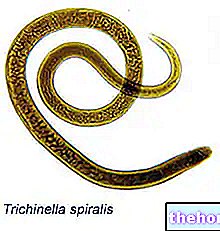Aspergillus: introduction
With Fusarium sp. And Penicillium sp., the genre Aspergillus is the title of the chapter on toxigenic molds: we are talking about fungal microorganisms capable of synthesizing a fair amount of toxins, whose toxigenic power is subordinated to the genotype of the producing strain.
In common parlance, the term Aspergillus refers to the genus this ubiquitous mold belongs to; the “aspergillosis”, on the other hand, identify the infections carried by this pathogen.

Unlike candidiasis, aspergillosis is contracted following the inhalation of Aspergillus spores.
Generality
Microorganisms belonging to the Aspergillus genus are cosmopolitan, ubiquitous fungi, found in soil, organic plant materials and animals. Aspergillus commonly grow on substrates rich in polysaccharides (e.g. amylose) and carbon (e.g. glucose and other monosaccharides). Starchy foods, such as potatoes and cereals, are the best growth reservoirs for many Aspergillus species. However, these molds can grow even in the total absence of essential nutrients: to give an example, Aspergillus niger grows freely on damp walls.
The propagation of conidia (spores) occurs through the air: it is estimated that man inhales a number of fungal cells equal to 6 x 107 daily, of which 8% is made up of Aspergillus. In closed environments or in areas where the vegetation is particularly generous, it is assumed that the share of inhaled fungal cells increases up to 6 x 108 per day!
Considering that such huge quantities of Aspergillus are inhaled, it is clear that these fungi cannot be defined as pathogens in all respects. For this reason, Aspergillus are considered to be apathogenic in the healthy host, components of the normal human commensal flora and common saprophytes in nature.
In sheep and cattle, Aspergillus infections can induce abortion; this microorganism is a parasite of birds, where it can cause even fatal lung infections.
The etymological analysis is curious and particular: the name of these fungi derives from the Latin phrase "asperges, aspergillus", which means sprinkler (tool used by the priest to sprinkle the people with holy water). In the distant 1729 the priest P.A. Micheli cataloged these microorganisms for the first time: after having carefully observed them under the microscope, he documented the peculiar "sprinkler" structure of "Aspergillus, giving the name to a new genus of microorganisms still recognized as such.
Microbiological description

Aspergillus tolerate high temperatures excellently, up to 50 ° C. They are defined as non-dimorphic fungi, of which only the mycelial form is known.
The reproduction of the aspergillus follows a typically conidal modality. Although the vast majority of aspergilli do not reproduce sexually, some species have been documented capable of forming sexual structures called cleistocytes.
Under the microscope, the aspergillus has these characteristics:
- Conidal head, consisting of conidia, phialides and metules
- The terminating stem is called conidophore (with conidophore hyphae), having a swelling called vesicle
Toxins are the products of virulence secreted by Aspergillus: among these, aflatoxin confers hepatotoxicity and (seems) carcinogenicity and teratogenicity. Glycotoxin, on the other hand, is useful for aspergillus to inhibit phagocytosis by macrophages and the activation of B lymphocytes.
The most important enzymes are elastase, protease and catalase.

Classification

The main species of medical interest belonging to the Aspergillus genus include:
Aspergillus flavus: of great pathological interest, this aspergillus produces aflatoxins, toxic mycotoxins dangerous for humans and animals. The "preferred" substrate for this species appears to be flour. Forms yellow colonies with a sharp margin. It has generally spherical vesicles, the phialides are arranged in double series (only rarely unique) and the conidiophores are wrinkled.
Aspergillus fumigates: the most common and most widespread species in nature (90% of Aspergillus). Forms green colonies delimited by a white outline; the margin of the colonies is clear and has a granular surface. The vesicles of this aspergillus are clavate, the phialides are arranged in a single series and the conidiophores are smooth.
Aspergillus niger: the colony takes on a whitish appearance, with a peculiar black dot (which corresponds to the aspergillary head). The margins are irregular, the vesicles spherical, the phialides arranged in single or double series and the conidiophores smooth. The Aspergillus niger they are exploited by man to produce citric acid and some enzymes.
Aspergillus versicolor: the name of the species recalls the particular polychromy of the colonies: green, pink, yellow
Also Aspergillus clavatus and Aspergillus nidulans they are kind of Aspergillus rather widespread, although less known than A. flavus, TO. fumigates and from. Niger.
Risk factors
We have analyzed that Aspergillus infections appear only in the presence of some predisposing conditions. Medical statistics show that patients with compromised immune systems are believed to be at increased risk for Aspergillus infections. However, immunosuppressed people are not the only targets of Aspergillus infections: asthmatics, transplant recipients, leukemics, chemotherapy patients, long-term steroid patients and cystic fibrosis, HIV or COPD patients are susceptible to infections in general. , including those from Aspergillus.
Aspergillus infections
The (relative) rarity of Aspergillus infections is justified by the typically opportunistic character of aspergillosis. Despite what has been stated, it seems that the "incidence of invasive forms has dramatically increased over the past twenty" years. Aspergillosis can manifest itself in several forms:
- primary / secondary invasive form
- non-invasive primary form
- dermatosis
- nasal-orbital infections
- otomycosis and onychomycosis
- secondary invasive bronchopulmonary form (or allergic broncho-pulmonary infection due to Aspergillus)
Considering the importance and the heterogeneity of the infections carried by Aspergillus, the topic will be analyzed in depth in the next article.
Other articles on "Aspergillus"
- Aspergillosis: Aspergillus infections
- Aspergillosis - Medicines for the treatment of Aspergillosis




























